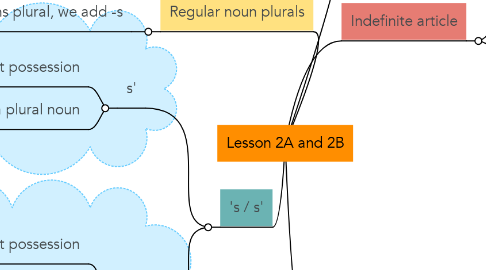
1. Regular noun plurals
1.1. To make most nouns plural, we add -s
1.1.1. When a noun ends in a vowel + -y, we add -s
1.1.1.1. day - days
1.1.2. Exceptions
1.1.2.1. When a noun ends in a consonant + -y, the -y changes to -i and we add -es.
1.1.2.1.1. baby - babies
1.1.2.2. When a noun ends in -ch, - sh, -ss, -s or -x, we add -es.
1.1.2.2.1. Adress - adresses
2. 's / s'
2.1. s'
2.1.1. We use s' to talk about possession
2.1.2. We use s'after a plural noun
2.2. 's
2.2.1. We use 's to talk about possession
2.2.2. We use 's after a singular noun
2.2.3. Exceptions
2.2.3.1. When a singular noun ends in -s, we don't add an extra -s. Just an '.
3. Possessive adjectives
3.1. We use them before nouns to talk about something that belongs to someone
3.1.1. Our
3.1.1.1. Plural
3.1.1.1.1. Onze
3.1.2. Your
3.1.2.1. Singular
3.1.2.1.1. Jouw, uw
3.1.2.2. Plural
3.1.2.2.1. Jullie, uw
3.1.3. Their
3.1.3.1. Plural
3.1.3.1.1. Hun
4. Indefinite article
4.1. a
4.1.1. We use a before a noun when we talk about one person or thing
4.1.2. We use a before a consonant sound
4.1.3. Example
4.1.3.1. (a book)
4.2. an
4.2.1. We use an before a noun when we talk about one person or thing
4.2.2. We use an before a vowel sound
4.2.2.1. a
4.2.2.2. e
4.2.2.3. i
4.2.2.4. o
4.2.2.5. u
4.2.3. Example
4.2.3.1. (an apple)
5. Demonstrative pronouns
5.1. Things or people that are near to us.
5.1.1. This
5.1.1.1. Dit
5.1.1.2. Deze
5.1.2. These
5.1.2.1. Die
5.2. Things or people that aren't near to us.
5.2.1. Those
5.2.1.1. Die
5.2.2. That
5.2.2.1. Die
5.2.2.2. Dat
